Having good handwriting as a teenager may increase your chances of getting good grades in school. The quality of your handwriting determines how fast you can write and how well your teachers are able to read your work.
If you are concerned about your handwriting and are looking for ways to improve it, then this blog post is for you. Keep reading for tips on how to improve your handwriting.
How To Improve Handwriting for Teenagers
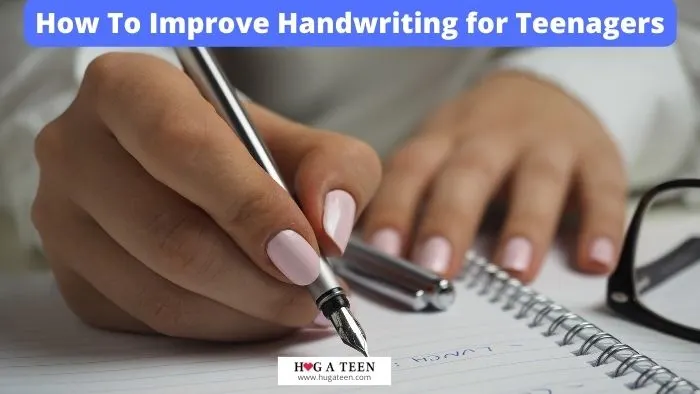
Handwriting problems aren’t just restricted to young children; teenagers also experience several common handwriting issues. There are several aspects to handwriting that can affect your writing style. If your teen has atrocious handwriting, they will likely need help forming letters. Here are some ways to start the process:
1. Decipher the problem
It is essential to understand the exact causes of your poor handwriting before you start to take any steps to improve on it. Knowing what is causing your handwriting issues will allow you to address them accordingly.
When trying to decipher the causes of your messy handwriting, try copying out a passage from a textbook or writing whatever is in your head at that moment; then, you can ask an adult to look at it objectively or try to decipher it by yourself.
Check if the letters of your writing are very slanted such that it’s difficult to differentiate between letters or if your lettering is too big or small. Also, check the spacing between each letter and the words you have written. Are there too many gaps, or is it too narrow?
All these assessments will help you better understand the primary causes of your bad handwriting. You can then know what to improve on.
You should check the following aspects of print handwriting:
Form – choose and stick to type one letter formation. Minimize the loops and ensure that all letters are closed properly. Using the correct letter formation will help improve the legibility of your writing.
Spacing – keep the letters close to each other, but don’t let them touch. Keep a slightly larger space between words.
Size – Make uppercase letters larger than lowercase letters and size them consistently on the lines of the page. Make descenders and ascenders long enough to differentiate from other letters but not too long to tangle with words on the line below.
Slanting – stick to one type of letter slant – straight, left, or right. You can even tilt your paper slightly to get a slant to your writing.
Watch this video for some tips on how to write neatly and improve your handwriting:
2. Check your writing tools
Choosing the writing tools that are most suitable for you is crucial if you want to have good handwriting. Generally, people either use a pencil or a pen to write. When choosing what you write with, check the width, grip, tip, and smoothness of the tool you use.
You may also have access to pens with rubber grips at the neck that helps to reduce pressure when you’re holding it. If you cannot find pens like these, you can find rubber grips at a nearby store and fix them on your pen or pencils.
Just make sure you are using a convenient tool for your writing.
3. Hold your pen correctly
Hold your pen near the writing tip, as this will give you better control in forming your letters. Try not to grip too hard, as this will tire your hand quickly. The most efficient grip is the Dynamic Tripod grip. Holding your pen like this allows you to write neatly and for a long time, as long as you don’t grip it too tightly.
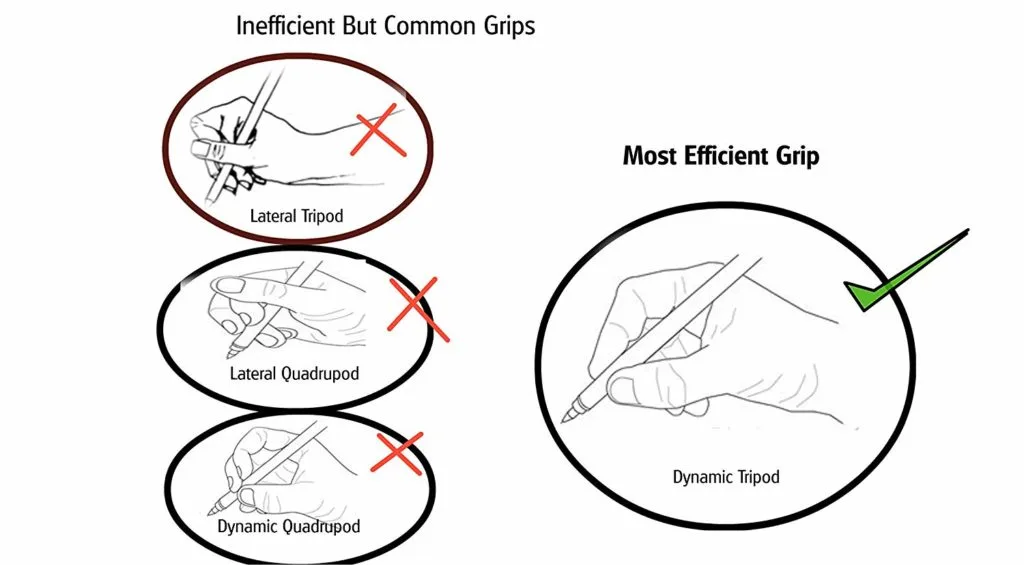
You can get a particular grip trainer if you want to practice holding your pen correctly.
Once you’ve practiced this at home, you can get comfort grips to help relieve finger pressure and cramping.
4. Use lined paper
The use of lined paper keeps the letters consistent in size and prevents the words from angling. You can also use paper with raised lines, which provides a tactile cue to help you stay within the lines.
5. Try worksheets
You can improve your handwriting with the aid of cursive or print worksheets. Practicing regularly on a worksheet will help improve your ability to use the pen, build your confidence, and aid legible handwriting. Worksheets can be a guide for you.
For teens that need more advanced handwriting practice for cursive, they can try this fantastic workbook to improve their cursive writing fluency:
What Causes Poor Handwriting?
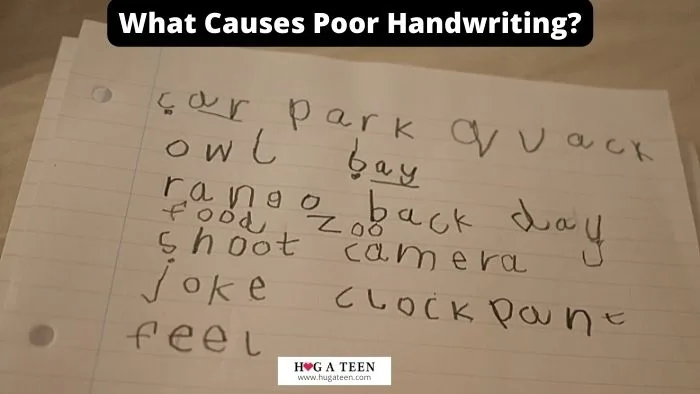
Poor handwriting is often a result of poor motor skills. These are sometimes called developmental coordination disorders, often referred to as DCD. Handwriting involves several different movements, including positioning the body and applying the correct amount of pressure. Causes of poor handwriting include:
1. Wrong grip of writing tool
Gripping your writing tool correctly plays a significant role in developing your handwriting. A proper way to hold a pen or pencil is by using your thumb, index finger, and middle finger to form the dynamic tripod grasp. Using the incorrect pencil grip will make your hand muscles get tired faster when compared to gripping properly. This may make you struggle with writing and write poorly.
2. Dysgraphia
Dysgraphia is a learning disability that affects one’s ability to write as a direct result of affecting their fine motor skill. It affects legibility, word spacing, spelling, and sizing. Teenagers with dysgraphia often struggle to articulate their thoughts on paper, stay within the margins, and form letters and shapes. This neurological condition can be the reason for a teen’s poor handwriting. A lot of children with handwriting difficulties don’t properly organize their information on the page as well.
3. Dyslexia
Dyslexia is another learning disability that affects the areas of the brain and impacts one’s ability to process language. Reading is done by connecting the words on a sheet with the sounds produced by these words. The patterns of the letters are then reconstructed while writing.
However, teenagers with dyslexia experience difficulty in deciphering these patterns and forming the links. As a result, they may find it challenging to understand the rhythmic movement or flow of words while writing, which can lead to poor handwriting.
4. Inadequate guidance
Learning to write legibly requires guidance and support. Teenagers have to be taught the right way to write legibly both in the classroom and at home while they are still kids.
Unfortunately, handwriting instruction is often stopped in junior school, especially in the era of classroom technology. Inadequate training on the proper way to write makes children grip pens and pencils incorrectly and develop a poor style of writing which can result in poor handwriting when they grow to become teenagers.
Can you improve your handwriting as a teen?
Handwriting can be improved at any age, including when you are a teenager. Improving your handwriting is not only a skill to practice in primary school. Poor handwriting is like a poor habit that you can change. By learning new methods, your handwriting will improve.
Strategies To Improve Handwriting

Here are some simple strategies you can use to improve your handwriting as a teenager:
1. Write slowly
When trying to improve your handwriting, try to write slower than you would normally write. This would help you properly examine your handwriting and see what is most important and bothering you. As a result of technology, we spend more time typing when compared to the time we spend writing, so it is expected that you are slower when you are writing.
2. Check the height and size of your lettering
The most common issue teenagers face in writing is that their letterings are either too small or too big. This might be the major reason your handwriting looks illegible and messy. Try to ensure that your letters are more aligned and have more or less the same size and height. This is why you must write in ruled lines, as they help improve writing sizes. As small as this seems, this activity for handwriting skills will improve your overall handwriting.
3. Check the spacing of your letters
It is important to address spacing issues with students when they are writing. When letters are pressed up against each other or words are squished, legibility is compromised.
4. Improve your pencil grip
Learn the proper positioning of the wrist and fingers in a functional pencil grasp. Once you are aware of how you should hold your pen or pencil, practice your letter formation. It might feel challenging at first, especially if you’ve never held your pen correctly before, so you will need to constantly check that you have the correct pencil grip while practicing until it becomes easier.
5. Watch handwriting videos
Technology has made everything easier, including handwriting. You can use this to your benefit. Look for videos of good calligraphers and watch them explain writing in detail. Several of these videos are available online. All you have to do is choose a style that is suitable and convenient for you and then follow the style. This is one of the best strategies for improving your handwriting skills.
6. Be patient
This is very important when practicing good handwriting; improvement takes time, so you must be patient. Try not to compare yourself with others who seem to have better handwriting than you; instead, keep practicing. You might not see any improvement at first, especially when you try to write faster, but stick to it, and you’ll soon improve your motor memory. When you give yourself more time, you will be amazed at the results you see.
Activities To Improve Handwriting
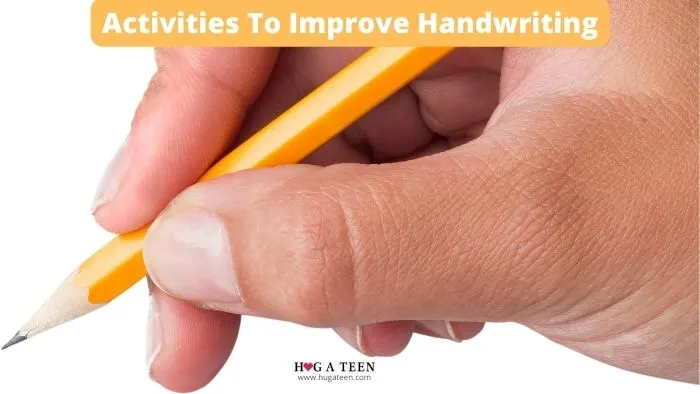
1. Try copying handwriting that you love
This can be the handwriting of someone you found online or simply the style of handwriting of someone you know, such as a friend or a sibling. The easiest way to see improvement in your writing is to copy someone’s own that you like and admire. At first, your handwriting might not look similar to the one you are copying, but it will improve with time.
Understand that you want to create your own writing style, not make yours look exactly like the one you are copying. It is, however, useful to copy someone else’s handwriting until you can get an idea of what you want your handwriting to look like.
2. Practice consistently
You can achieve this by using handwriting worksheets or any handwriting workbook available. Some stores or even bookshops sell some of these.
Practicing handwriting might seem like an activity that kids do at school, but giving it a try is definitely worth it. If you’re unable to get a worksheet, look for any that you can find online, print them out and use them for practice. This is one of the best and most guaranteed ways to improve your handwriting.
Fun Ways To Improve Handwriting

Improving your handwriting can include some fun and creative writing activities that you might not have previously considered.
1. Journaling
As discussed, one of the most important ways to improve your handwriting is to practice daily; however, there’s an easier way to go about this, and that is by journaling. Journaling has many benefits; besides helping you improve your handwriting, it also helps you clear your mind of negative emotions and reduces stress. If you try to journal every day, you can at least get to write every day. Five minutes of daily writing will help your handwriting improve greatly.
Although this might seem minor, you must remember that the main thing is to be consistent, and all you need are daily little steps.
You might also like to read: 30 Simple Yet Gorgeous Bullet Journal Weekly Spreads
2. Practice forming letters in the sand
Improving your handwriting can be fun, and one of the ways you can achieve this is by writing in the sand. When you’re at the beach, have fun writing names or messages using a stick or index finger.
One of the bonuses of this sensory handwriting activity is that cleaning what you’ve written is easy and quick.
3. Encourage drawing
To enhance your handwriting and improve it, you need to correctly hold a pencil with proper coordination and dexterity. This is where drawing helps, as it requires the same set of skills. Drawing is a fun way of improving not just your handwriting but also your hand muscles. The more time you spend drawing, the better. It will also help improve your coordination skills, lettering height, and spacing.
Handwriting Practice For High School Students
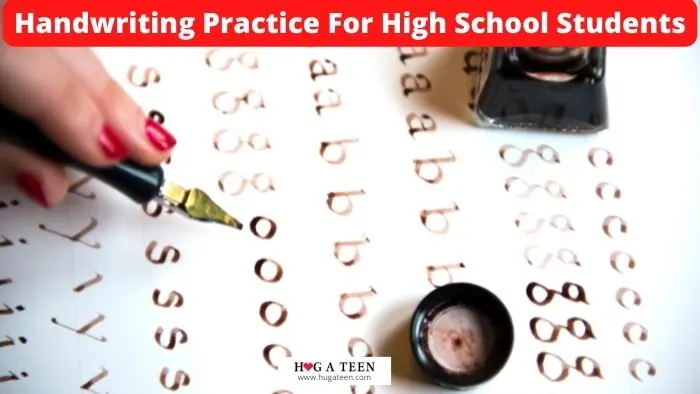
1. Be consistent
As a high school student, the best way to practice handwriting is by being consistent. You can choose to write in either cursive letters, printed, or joined-up styles. What matters most is legibility and speed. Improving your handwriting may not always be about writing faster, especially if you’re learning in a cursive style; consistency is, however, key.
2. Use lined paper
Ensure you always write on a squared or lined sheet. Any work that is uneven and doesn’t sit well on a line can be hard to read and scan. Using a lined sheet to practice is a helpful handwriting tool. Understanding line awareness and placing letters accurately on the writing lines is a handwriting skill that occupational therapists often address.
3. Practice hand muscle exercises
Practicing hand muscle exercises is also good for you. It increases your posture when writing and enhances your ability to properly grasp writing tools. Examples of exercises you can try from time to time include throwing and catching or flexing a rubber band.
Related Handwriting Questions
What is the fastest way to improve your handwriting?
The fastest way to improve your handwriting is to create a personal development plan that works for you. Practice daily, and keep to a good, defined posture. Try dedicating at least five minutes daily to practicing your handwriting, and you will notice improvements fast.
Is there an app to improve handwriting?
Some apps can help improve your handwriting, called calligraphy apps. Some of these apps contain tracing alphabets in different handwriting font choices.
Check out LazyDog and Stylograph to get you started.
How long does it take to improve your handwriting?
It takes three weeks to be able to write the new way you have learned at a moderate to fast rate. It will take about three months to write rapidly without occasional relapses to your old handwriting. For you to experience comfort with your new handwriting, it can take you up to a year.
Which handwriting is best for students?
You will need to find which handwriting is best for you. Although cursive writing is widely considered to be the better handwriting style, it is not easy for everyone, especially for exams. Cursive or joined-up handwriting can improve speed as it flows more easily, but only if you have practiced it for quite a long time. Print handwriting is easier to learn quickly. As long as you keep your letter size and spacing consistent, print writing can be easier to read than cursive.
Can handwriting be improved at any age?
Handwriting can be improved at any age. All you need to have is steady hands and lots of practice. This implies that an aged person can still improve their handwriting as long as their motor skills are still fine. What this requires is the identification of one’s writing flaws and consistency in handwriting practice.
Conclusion
Having good handwriting is important, especially as a teenage student because it plays an essential role in the education system. Poor handwriting can cause illegibility and lead to bad grades.
The major causes of bad handwriting are learning disabilities, wrong grip on pen and pencil, and lack of practice. However, handwriting can be improved by deciphering the problem and with constant practice.




